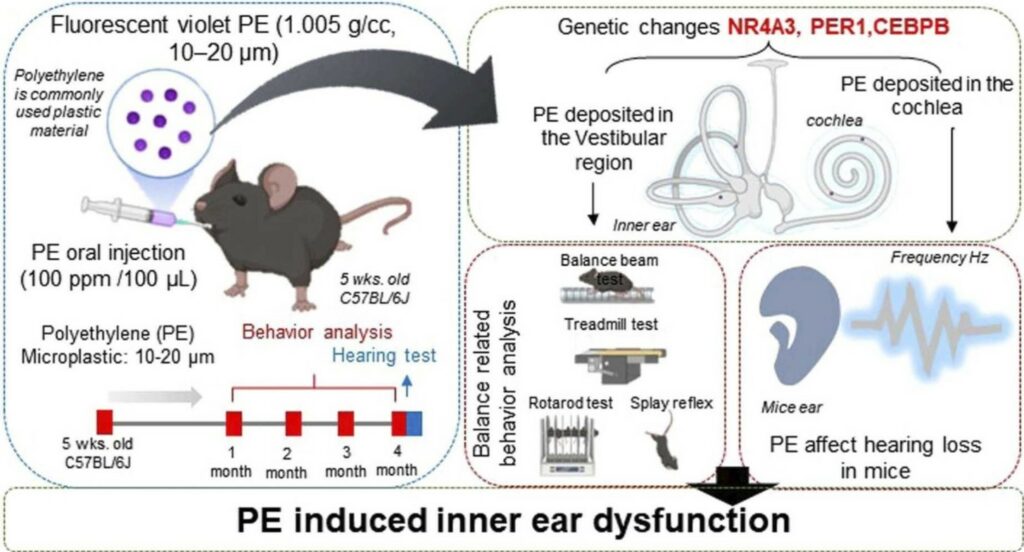Researchers have uncovered significant findings linking microplastic exposure to hearing loss and balance issues in mice. The study, published in the Journal of Hazardous Materials, delves into the potential health risks posed by microplastics, particularly polyethylene (PE), a common plastic found in various consumer products.
The study, led by Javeria Zaheer and colleagues, investigated the effects of microplastic polyethylene on the inner ear function of mice. Mice were divided into control and PE-exposed groups, with the latter receiving daily oral doses of 100 ppm/100 μL of PE for four months.
The researchers aimed to determine whether the microplastics would accumulate in the inner ear and cause functional impairments such as hearing loss and balance disorders.

Graphical abstract. Credit: Zaheer, et al, https://www.sciencedirect.com/science/article/pii/S0304389424017722
Key Findings
- Microplastic Accumulation: The study confirmed the accumulation of PE in the cochlea and vestibular regions of the inner ear. The highest concentration of PE particles was found in the basal turn of the cochlea, likely due to its proximity to the blood supply.
- Hearing Loss and Balance Issues: Mice exposed to PE showed significant increases in hearing thresholds, indicating hearing loss. Additionally, these mice exhibited balance disorders, demonstrated through various behavioral tests, including the treadmill and rotarod tests, which assess motor coordination and balance stability.
- Gene Expression Changes: Transcriptome analysis revealed that exposure to PE led to the upregulation of genes associated with inflammation and apoptosis, such as PER1, NR4A3, and CEBPB. These genetic changes were confirmed through qRT-PCR, immunofluorescence staining, and western blotting, suggesting that PE exposure triggers molecular pathways leading to inner ear damage.
- Decreased Glucose Metabolism: Using 18F-FDG PET scans, researchers found decreased glucose metabolism in the auditory cortex of PE-exposed mice, aligning with clinical findings of hearing loss.
Implications
This study highlights the potential health risks of microplastic exposure, particularly in relation to hearing and balance. Given the widespread presence of microplastics in the environment and their detection in human tissues, these findings raise concerns about the long-term impact of plastic pollution on human health.
The researchers suggest that further studies are needed to explore the specific mechanisms by which microplastics induce inner ear dysfunction. Additionally, investigating the impact of different types and sizes of microplastics on auditory health will be crucial for developing comprehensive risk assessments.
Citation
Zaheer, J., Lee, H. S., Kim, S., Jang, J., Kim, H., Choi, J., Park, M.-H., & Kim, J. S. (2024). Microplastic polyethylene induced inner ear dysfunction in murine model. Journal of Hazardous Materials, 476, 135193. https://doi.org/10.1016/j.jhazmat.2024.135193
Source: Journal of Hazardous Materials






